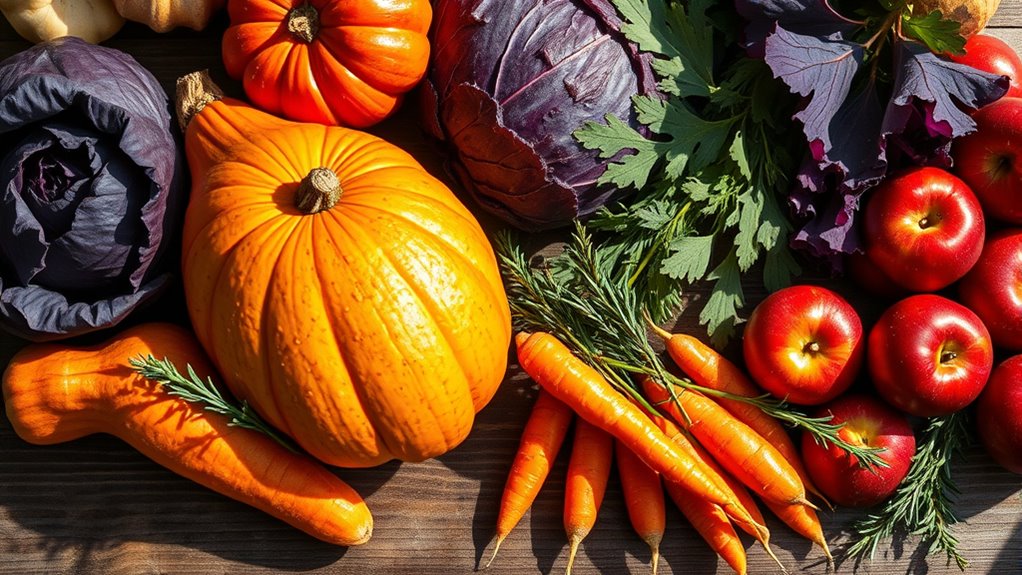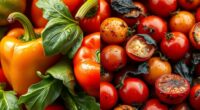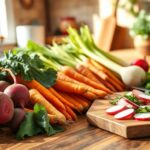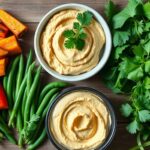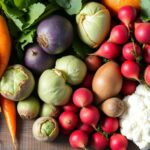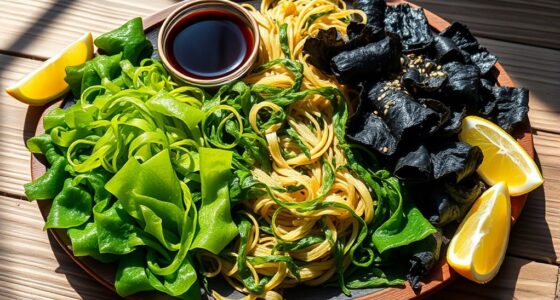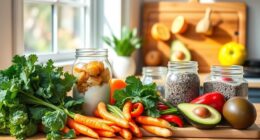Seasonal meal prep in autumn and winter involves using ingredients like root vegetables, squash, and leafy greens to create flavorful, budget-friendly dishes. Roast, batch-cook soups, and freeze extras for convenience. Incorporate herbs like thyme and rosemary to boost flavor. By choosing in-season produce, you guarantee meals are fresh, nutritious, and satisfying throughout the season. Keep exploring for more tips on how to make the most of seasonal ingredients and keep meals exciting.
Key Takeaways
- Focus on root vegetables, squash, and leafy greens for flavorful, seasonal meal prep options.
- Batch-cook hearty soups and stews using in-season ingredients for convenience and nutrition.
- Incorporate herbs like thyme and rosemary to enhance natural flavors of autumn and winter produce.
- Roast vegetables to deepen flavors and create versatile side dishes for various meals.
- Plan weekly menus around seasonal ingredients to maximize freshness, affordability, and culinary variety.
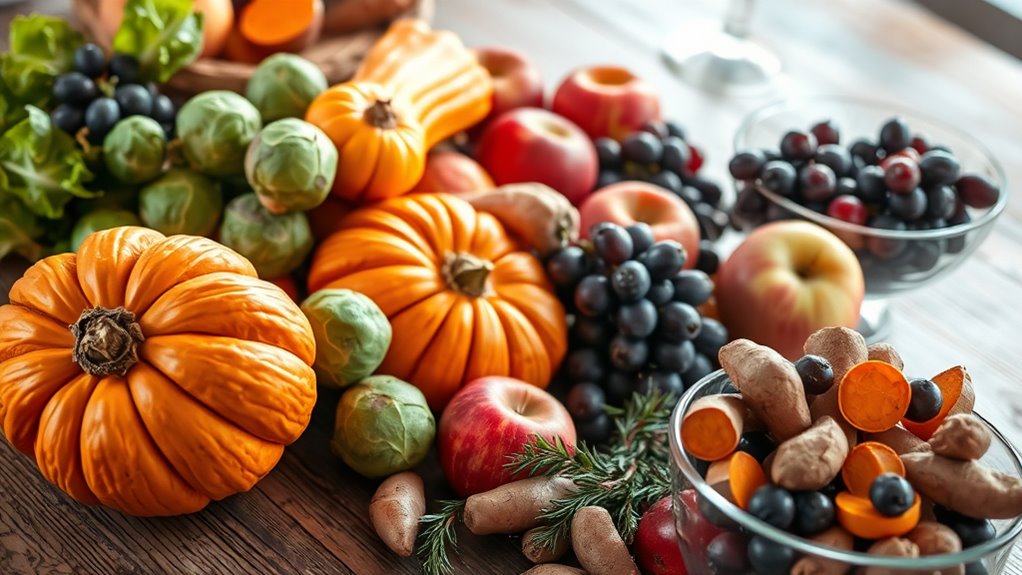
Have you ever wondered how to make meal prepping more efficient and enjoyable throughout the year? One great way is to focus on seasonal produce, especially during autumn and winter. These seasons offer a variety of ingredients that can turn your weekly meals into comforting, nutritious delights. By planning around what’s in season, you can save money and enjoy ingredients at their peak flavor and freshness. Plus, using seasonal vegetables and fruits can inspire new recipes that keep your meal prep interesting.
During fall and winter, root vegetables like carrots, parsnips, and sweet potatoes become your best friends. They’re versatile, filling, and perfect for hearty stews or roasted as side dishes. Incorporate squash varieties such as butternut or acorn into your meal prep to add sweetness and texture to your dishes. Leafy greens like kale and collard greens also thrive in colder weather, providing a nutritious boost to your recipes. These ingredients are ideal for making nutritious, easy-to-prepare soup recipes that warm you up on chilly days. Think of blending roasted butternut squash with spices for a creamy soup or simmering kale with beans and garlic for a hearty, veggie-packed broth. Hearty stews become even more satisfying when you include seasonal produce—think beef or vegetable stews loaded with carrots, potatoes, and celery, simmered to perfection.
To maximize your meal prep, consider batch-cooking these soups and stews ahead of time. Store them in the fridge or freezer, and you’ll have nourishing options ready to heat up during busy weekdays. This approach not only saves time but also ensures you’re eating wholesome, homemade meals. When shopping, look for produce that’s in season—these items are more affordable and often tastier. You can also get creative by combining seasonal ingredients in different ways, ensuring your meals don’t become monotonous.
Incorporate seasonal produce into your meal prep routine by planning your recipes around what’s available. For example, create a weekly menu that features a hearty stew on one day and a vegetable-packed soup on another. Add herbs like thyme and rosemary to enhance flavors naturally. Don’t forget to experiment with textures and flavors—try roasting vegetables for depth or blending ingredients into creamy purees. This way, your meal prep stays exciting and sustainable, helping you enjoy the comfort of homemade, seasonal dishes all winter long.
Frequently Asked Questions
How Can I Maximize Shelf Life of Winter Vegetables?
To maximize the shelf life of winter vegetables, you should use proper preservation techniques and store them in suitable storage containers. Keep root vegetables in a cool, dark, and humid place, like a cellar or crisper drawer, and use airtight containers for leafy greens to prevent moisture loss. Regularly check for spoilage, remove any damaged pieces, and avoid overcrowding to guarantee your vegetables stay fresh longer.
What Are Creative Ways to Use Seasonal Squash?
You won’t believe how versatile squash can be. Start by exploring comforting squash soup recipes, blending roasted squash with spices for warmth. Then, get inventive with stuffed squash ideas—fill halved squash with grains, veggies, or cheese, and bake to perfection. These creative uses turn seasonal squash into stunning dishes that surprise and delight. Ready to elevate your winter meals? Plunge into these delicious, unexpected ways to enjoy squash!
How Do I Store Root Vegetables for Long-Term Use?
To store root vegetables long-term, focus on root vegetable preservation by keeping them in a cool, dark, and well-ventilated space. Use storage container choices like mesh bags, wooden crates, or paper bags to prevent moisture buildup and rot. Make sure to remove any damaged or sprouted vegetables before storing. Check them regularly and keep the storage area around 32-40°F (0-4°C) for ideal freshness.
Are There Gluten-Free Meal Prep Options With Autumn Produce?
Yes, you can make gluten-free meal prep options with autumn produce. Incorporate gluten-free grains like quinoa or rice into hearty autumn salads with roasted squash, apples, and kale. These salads keep well and are easy to prepare in advance. You can also add roasted root vegetables, nuts, and a simple vinaigrette for flavor. This way, you enjoy nutritious, gluten-free meals that celebrate seasonal flavors all week long.
How Can I Incorporate Seasonal Fruits Into Savory Dishes?
Think of seasonal fruits as the melody in a savory dish’s symphony. You can incorporate them by fruit pairing with hearty ingredients like squash or root vegetables, adding a touch of sweetness. Use techniques like roasting or sautéing to enhance their natural flavors, ensuring flavor balancing. Mix in apples or pears for a hint of tartness, elevating your dishes with seasonal freshness that delights the palate.
Conclusion
Just as a cozy fireplace welcomes you after a chilly day, embracing seasonal produce warms both your body and soul. Think of your meal prep as tending a garden—you nurture it now, and it rewards you with vibrant flavors and nourishment through autumn and winter. By choosing seasonal ingredients, you’re crafting a comforting tapestry of flavors that sustain and delight. So, keep tending your culinary garden, and enjoy the bountiful harvest that awaits.
Ilana has been a vegan for over 10 years. She originally made the switch for health reasons, but soon found herself becoming more and more passionate about the ethical and environmental implications of a vegan lifestyle. Ilana is the author of The Graceful Kitchen, a blog all about veganism. She loves to cook up delicious and nutritious vegan meals, and share her recipes with others who are interested in leading a cruelty-free life. Ilana is also a strong advocate for using whole foods as the foundation of a healthy diet, and believes that going vegan is one of the best ways to achieve this.
